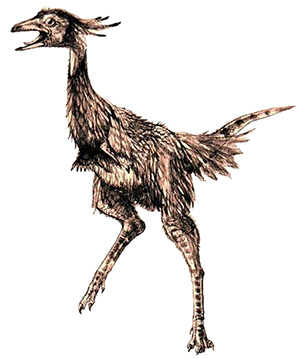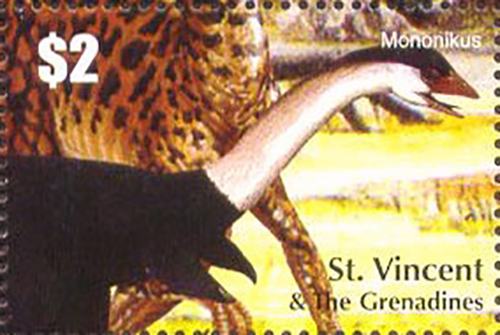Mononykus olecranus Perle et al., 1993

(Da: en.wikipedia.org)
Phylum: Chordata Haeckel, 1874
Subphylum: Vertebrata Cuvier, 1812
Classe: Dinosauria Owen, 1841
Ordine: Saurischia Seeley, 1887
Famiglia: Alvarezsauridae Bonaparte, 1991
Genere: Mononykus Perle et al., 1993
Descrizione
Questo dinosauro è noto a molti per una caratteristica che lo distingue da tutti i teropodi conosciuti, eccetto quelli appartenenti alla famiglia degli alvarezsauridi, di cui fa parte: braccia cortissime munite di un voluminoso artiglio. Gli scienziati si sono subito chiesti quale fosse la loro funzione: da alcuni è stato ipotizzato che servissero per stanare dai loro nidi le termiti di cui doveva nutrirsi, oppure, come potrebbe essere accaduto al Tirannosaurus rex, per tenere stretti i due partner durante l'accoppiamento. Gli occhi erano di notevoli dimensioni, per vedere meglio al buio. Il becco forse era munito di piccoli denti. Le sue zampe erano forti, che gli permettevano di inseguire prede o scappare dai predatori velocemente, ed erano munite di piedi con degli artigli che gli servivano a sferrare attacchi ai predatori e alle prede. Il corpo probabilmente era munito di piume che lo riscaldavano durante i periodi di gelo. Aveva un collo flessibile e lungo che utilizzava per prendere rapidamente le prede. Era lungo 1 m. Gli scienziati pensano che questo dinosauro si fosse evoluto da un uccello in grado di volare e che si fosse adattato ad inseguire le prede a terra. Si nutriva di piccoli mammiferi, insetti, lucertole e forse anche piante.
Diffusione
Vissuto 75 milioni di anni fa nel Cretaceo in Mongolia.
Bibliografia
–Perle, A.; Norell, M. A.; Chiappe, L. M.; Clark, J. M. (1993). "Flightless bird from the Cretaceous of Mongolia". Nature. 362: 623-626.
–Perle, A.; Chiappe, L. M.; Rinchen, B.; Clark, J. M.; Norell, M. A. (1994). "Skeletal morphology of Mononykus olecranus (Theropoda, Avialae) from the late Cretaceous of Mongolia". American Museum Novitates (3105): 1-29.
–Perle, A.; Norell, M. A.; Chiappe, L. M.; Clark, J. M. (1993). "Correction: Flightless bird from the Cretaceous of Mongolia". Nature. 363 (188).
–Suzuki, S., Chiappe, L. M., Dyke, G.J., Watabe, M., Barsbold, R., and Tsogtbaatar, K. (2002). "A new specimen of Shuvuuia deserti Chiappe et al., 1998 from the Mongolian Late Cretaceous with a discussion of the relationships of alvarezsaurids to other theropod dinosaurs." Contributions in Science, 494: 1-18.
–Chiappe, L. M., Norell, M. and Clark (1998). "The skull of a relative of the stem-group bird Mononykus." Nature, 392: 275-278.
–Dinosaurs of the Gobi. Mongolia: BBC Horizon. 1993.
–Mortimer, M. (2004), "Ornithomimosauria" Archived 2013-09-29 at the Wayback Machine, The Theropod Database, accessed June 30, 2009.
–Lee, S.; Park, J.-Y.; Lee, Y.-N.; Kim, S.-H.; Lü, J.; Barsbold, R.; Tsogtbaatar, K. (2019). "A new alvarezsaurid dinosaur from the Nemegt Formation of Mongolia". Scientific Reports. 9 (1): 15493.
–Choiniere, J. N.; Xu, X.; Clark, J. M.; Forster, C. A.; Guo, Y.; Han, F. (2010). "A basal alvarezsauroid theropod from the Early Late Jurassic of Xinjiang, China". Science. 327 (5965): 571-574.
–Paul, G. S. (2016). The Princeton Field Guide to Dinosaurs (2nd ed.). Princeton, New Jersey: Princeton University Press. p. 137.
–Schweitzer, M. H., J. A. Watt, R. Avci, L. Knapp, L. Chiappe, M. Norell & M. Marshall. (1999). "Beta-keratin specific immunological reactivity in feather-like structures of the Cretaceous alvarezsaurid, Shuvuuia deserti." Journal of Experimental Zoology, 285: 146-157.
–"'Prehistoric Planet,' a Stunning New Series, Depicts Dinosaurs Like Never Before | Audubon". www.audubon.org. May 23, 2022.
–Choiniere, Jonah N.; Neenan, James M.; Schmitz, Lars; Ford, David P.; Chapelle, Kimberley E. J.; Balanoff, Amy M.; Sipla, Justin S.; Georgi, Justin A.; Walsh, Stig A.; Norell, Mark A.; Xu, Xing; Clark, James M.; Benson, Roger B. J. (2021-05-07). "Evolution of vision and hearing modalities in theropod dinosaurs". Science. 372 (6542): 610-613.
–Senter, P. (2005). "Function in the stunted forelimbs of Mononykus olecranus (Theropoda), a dinosaurian anteater". Paleobiology Vol. 31, No. 3 pp. 373-381.
–Rothschild, B., Tanke, D. H., and Ford, T. L., 2001, Theropod stress fractures and tendon avulsions as a clue to activity: In: Mesozoic Vertebrate Life, edited by Tanke, D. H., and Carpenter, K., Indiana University Press, p. 331-336.

|
Data: 28/09/2016
Emissione: Animali preistorici dei deserti Stato: Guinea-Bissau Nota: Emesso in un foglietto di 5 v. diversi |
|---|

|
Data: 05/11/2003
Emissione: Dinosauri Stato: St. Vincent and the Grenadines |
|---|